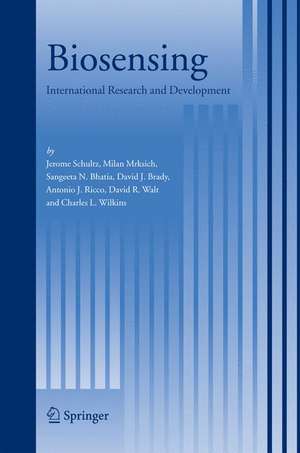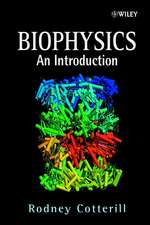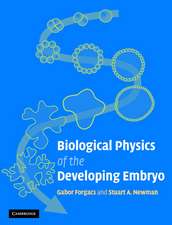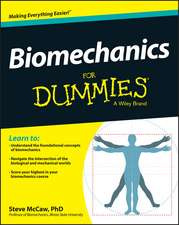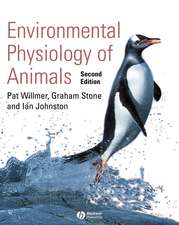Biosensing: International Research and Development
Editat de Jerome Schultz, Milan Mrksich, Sangeeta N. Bhatia, David J. Brady, Antionio J. Ricco, David R. Walt, Charles L. Wilkinsen Limba Engleză Hardback – 19 apr 2006
| Toate formatele și edițiile | Preț | Express |
|---|---|---|
| Paperback (1) | 950.33 lei 6-8 săpt. | |
| SPRINGER NETHERLANDS – 19 oct 2010 | 950.33 lei 6-8 săpt. | |
| Hardback (1) | 956.50 lei 6-8 săpt. | |
| SPRINGER NETHERLANDS – 19 apr 2006 | 956.50 lei 6-8 săpt. |
Preț: 956.50 lei
Preț vechi: 1166.47 lei
-18% Nou
Puncte Express: 1435
Preț estimativ în valută:
183.05€ • 198.76$ • 153.76£
183.05€ • 198.76$ • 153.76£
Carte tipărită la comandă
Livrare economică 22 aprilie-06 mai
Preluare comenzi: 021 569.72.76
Specificații
ISBN-13: 9781402040573
ISBN-10: 1402040571
Pagini: 388
Ilustrații: XXX, 388 p. 31 illus.
Dimensiuni: 155 x 235 x 23 mm
Greutate: 0.76 kg
Ediția:2006
Editura: SPRINGER NETHERLANDS
Colecția Springer
Locul publicării:Dordrecht, Netherlands
ISBN-10: 1402040571
Pagini: 388
Ilustrații: XXX, 388 p. 31 illus.
Dimensiuni: 155 x 235 x 23 mm
Greutate: 0.76 kg
Ediția:2006
Editura: SPRINGER NETHERLANDS
Colecția Springer
Locul publicării:Dordrecht, Netherlands
Public țintă
ResearchCuprins
Infrastructure Overview.- Optical Biosensing.- Electro-Based Sensors and Surface Engineering.- Cell and Tissue-Based Sensors.- Mass Spectrometry and Biosensing Research.- Microfabricated Biosensing Devices: MEMS, Microfluidics, and Mass Sensors.- Information Systems for Biosensing.
Textul de pe ultima copertă
The goal of this book is to disseminate information on the worldwide status and trends in biosensing R&D to government decisionmakers and the research community. The contributors critically analyze and compare biosensing research in the United States with that being pursued in Japan, Europe and other major industrialized countries.
Biosensing includes systems that incorporate a variety of means, including electrical, electronic, and photonic devices; biological materials (e.g., tissue, enzymes, nucleic acids, etc.); and chemical analysis to produce detectable signals for the monitoring or identification of biological phenomena. In a broader sense, the study of biosensing includes any approach to detection of biological elements and the associated software or computer identification technologies (e.g., imaging) that identify biological characteristics. Biosensing is finding a growing number of applications in a wide variety of areas, including biomedicine, food production and processing, and detection of bacteria, viruses, and biological toxins for biowarfare defense. Subtopics likely to be covered in this study include the following: Nucleic acid sensors and DNA chips and arrays, organism- and cell-based biosensors, bioelectronics and biometrics, biointerfaces and biomaterials; biocompatibility and biofouling, integrated, multi-modality sensors and sensor networks, system issues, including signal transduction, data interpretation, and validation, novel sensing algorithms, e.g., non-enzyme-based sensors for glucose, mechanical sensors for prosthetics, related issues in bio-MEMS and NEMS (microelectromechanical and nanoelectromechanical systems), possibly including actuators, applications in biomedicine, the environment, food industry, security and defense.
Particular emphasis will be on technologies that may lead to portable or fieldable devices/instruments. Important consideration will be given to an integrated approach to detection, storage,analysis, validation, interpretation and presentation of results from the biosensing system. Focus will be on research from the following disciplines:
BioMems & nano, optical spectroscopy, mass spectroscopy, chemometrics, pattern recognition, telemetry, signal processing, and toxicology.
Finally, beyond the above technical issues, the study will also address the following non-technical issues: Mechanisms for enhancing international and interdisciplinary cooperation in the field, opportunities for shortening the lead time for deployment of new biosensing technologies emerging from the laboratory, long range research, educational, and infrastructure issues that need addressed to promote better progress in the field, current government R&D funding levels overseas compared to the United States, to the extent data are available.
Biosensing includes systems that incorporate a variety of means, including electrical, electronic, and photonic devices; biological materials (e.g., tissue, enzymes, nucleic acids, etc.); and chemical analysis to produce detectable signals for the monitoring or identification of biological phenomena. In a broader sense, the study of biosensing includes any approach to detection of biological elements and the associated software or computer identification technologies (e.g., imaging) that identify biological characteristics. Biosensing is finding a growing number of applications in a wide variety of areas, including biomedicine, food production and processing, and detection of bacteria, viruses, and biological toxins for biowarfare defense. Subtopics likely to be covered in this study include the following: Nucleic acid sensors and DNA chips and arrays, organism- and cell-based biosensors, bioelectronics and biometrics, biointerfaces and biomaterials; biocompatibility and biofouling, integrated, multi-modality sensors and sensor networks, system issues, including signal transduction, data interpretation, and validation, novel sensing algorithms, e.g., non-enzyme-based sensors for glucose, mechanical sensors for prosthetics, related issues in bio-MEMS and NEMS (microelectromechanical and nanoelectromechanical systems), possibly including actuators, applications in biomedicine, the environment, food industry, security and defense.
Particular emphasis will be on technologies that may lead to portable or fieldable devices/instruments. Important consideration will be given to an integrated approach to detection, storage,analysis, validation, interpretation and presentation of results from the biosensing system. Focus will be on research from the following disciplines:
BioMems & nano, optical spectroscopy, mass spectroscopy, chemometrics, pattern recognition, telemetry, signal processing, and toxicology.
Finally, beyond the above technical issues, the study will also address the following non-technical issues: Mechanisms for enhancing international and interdisciplinary cooperation in the field, opportunities for shortening the lead time for deployment of new biosensing technologies emerging from the laboratory, long range research, educational, and infrastructure issues that need addressed to promote better progress in the field, current government R&D funding levels overseas compared to the United States, to the extent data are available.
Caracteristici
First book about the worldwide status and trends in biosensing R and D by leading scientists in the field for government decisionmakers and the research community Clarifies research opportunities and needs for promoting progress in the field generally Qualitative assessment of biosensing research in Western Europe and Japan in comparison to the United States Includes supplementary material: sn.pub/extras
